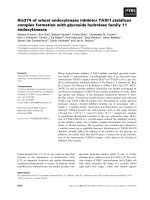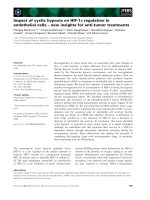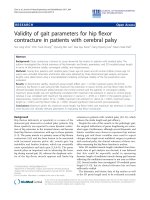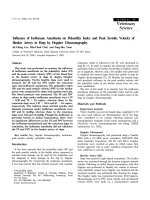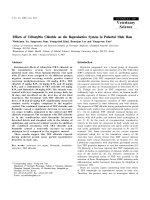báo cáo khoa học: " Influence of lip closure on alveolar cleft width in patients with cleft lip and palate" ppt
Bạn đang xem bản rút gọn của tài liệu. Xem và tải ngay bản đầy đủ của tài liệu tại đây (836.79 KB, 4 trang )
RESEARCH Open Access
Influence of lip closure on alveolar cleft width in
patients with cleft lip and palate
Wolfgang Eichhorn
1
, Marco Blessmann
2
, Oliver Vorwig
2
, Gerd Gehrke
3
, Rainer Schmelzle
2
, Max Heiland
2*
Abstract
Background: The influence of surgery on growth and stability after treatment in patients with cleft lip and palate
are topics still under discussion. The aim of the present study was to investigate the influence of early lip closure
on the width of the alveolar cleft using dental casts.
Methods: A total of 44 clefts were investigated using plaster casts, 30 unilateral and 7 bilateral clefts. All infants
received a passive molding plate a few days after birth. The age at the time of closure of the lip was 2.1 month in
average (range 1-6 months). Plaster casts were obtained at the following stages: shortly after birth, prior to lip
closure, prior to soft palate closure. We determined the width of the alveolar cleft before lip closure and prior to
soft palate closure measuring the alveolar cleft width from the most lateral point of the premaxilla/anterior
segment to the most medial point of the smaller segment.
Results: After lip closure 15 clefts presented with a width of 0 mm, meaning that the mucosa of the segments
was almost touching one another. 19 clefts showed a width of up to 2 mm and 10 clefts were still over 2 mm
wide. This means a reduction of 0% in 5 clefts, of 1-50% in 6 clefts, of 51-99% in 19 clefts, and of 100% in 14 clefts.
Conclusions: Early lip closure reduces alveolar cleft width. In most cases our aim of a remaining cleft width of
2 mm or less can be achieved. These are pro mising conditions for primary alveolar bone grafting to restore the
dental bony arch.
Background
The treatment of children with a cleft lip and palate
remains a challe nge. Beginning at birth, it is necessary
to balance several aspects of treatment such as growth,
esthetics, function, and ps ychosocial development. Espe-
cially in children with a complete bilateral cleft lip and
palate, many problems remain unsolved. Apart from
intrinsic tissue deficiency and anatomic aberrations,
there is difficulty in restoring the orbicularis oris muscle,
in creating a philtrum, and in lengthening the columella.
Furthermore, benefit of early orthopedic treatment is
still questioned. Unrestricted premaxillary growth also
gives rise to many problems. Surgeons have not reached
consensus regarding best type and timing of lip- and
palatal closure. Similarly, orthodontists have not reached
agreement on early management of the alveolar segment
position before lip closure. Some promoted the use of
active or passive intra-oral appliances in order to nor-
malize alveolar segment position before lip closure. This
would enable the surgeon to operate with less tension
on the soft tissues. Others have advocated the use of
extra-oral strapping placed. Finally, the influence of sur-
gery on further growth and stability a fter treatment are
topics still under discussion[1-10].Accordingtothe
Muenster treatment protocol an early lip closure is per-
formed at the age of 4-6 months [7], while Anastassov
and Joos prefer an age of 3 mon ths [5]. According to
the Hamburg treatment protocol lip closure is per-
formed even earlier at the age of 8 weeks in the mean
and can be classified as a very early lip closure.
The aim of the present study was to investigate the
influence of early lip closure on the width of the alveolar
cleft using dental casts.
Methods
37 patients (21 male, 16 female) were evaluated in this
study. A total of 44 clefts were investigated using plaster
casts, 30 unilateral and 7 bilateral clefts. All infants
* Correspondence:
2
Department of Oral and Maxillofacial Surgery, University Medical Center
Hamburg-Eppendorf, Martinistr. 52, 20246 Hamburg, Germany
Full list of author information is available at the end of the article
Eichhorn et al. Head & Face Medicine 2011, 7:3
/>HEAD & FACE MEDICINE
© 2011 Eichhorn et al; licensee BioMed Central Ltd. This is an Open Access article distributed under the terms of the Creative
Commons Attr ibution License ( which permits unrestricted use, distribution, and
reproduction in any medium, provided the original work is properly cited.
received a passive molding plate a few days after birth.
Theageatthetimeofclosureofthelipwas2.1month
in average (range 1-6 months). The one patient with the
age of 6 months suffered from a hydrocephalus, whereby
an earlier operation could not be realized. The surgical
procedure was performed according to Tennisson or
Millard. The closure of the soft palate was performed at
the age of 8.5 months in average (range 4-17 months).
Orthodontic plaster casts were obtained at the follow-
ing stages: shortly after birth, prior to lip closure, and
prior to soft palate closure. We determined the width of
the alveolar cleft before lip closure and prior to soft
palate closure measuring the alveolar cleft width from
the most lateral point of the premaxilla/anterior seg-
ment to the most medial point of the smaller segment
according to Sillmann and Robertson et al. [1,11].
Due to the small number of cases, a descriptive analy-
sis was perfor med. The reduction of alveolar cleft width
after lip closure in mm and in percent to the original
alveolar cleft width were calculated.
Results
After lip closure 15 clefts presented with a width of 0
mm, meaning that the mucosa of the segments of both
sides were in direct contact. 19 clefts showed a width of
up to 2 mm and 10 clefts were still over 2 mm wide.
The relative reduction compared to the original cleft
width revealed a reduction of 0 percent in 5 five clefts.
In one case an original cleft width of 0 mm before lip
closure did not enhance and stayed small. Small clefts
stayed small. 6 clefts showed a reduction of 1-50%, 19
a reduction of 51-99% and 14 a reduction of 100%.
A 100% reduction means that the cleft segments were in
direct contact (table 1).
Additional dental casts obtained in single cases at later
surgical procedures prove a rapid initial reduction of
alveolar cleft width followed by a reduced velocity of
movement (Figure 1, 2).
Discussion
Active maxillary appliances are constructed to move
alveolar segments in a predetermined manner with
controlled force. The use of pin-retained appliances to
expand collapsed alveolar segments while retracting the
premaxilla in the case of a bilateral cleft and in unilat-
eral cleft cases has been repeatedly advised [12-16].
Table 1 Alveolar cleft width and reduction of cleft width
at time of soft palate closure
Alveolar cleft width (mm) Number of patients
015
up to 2 19
more than 2 10
Reduction of cleft width (%)
05
1-50 6
51-99 19
100 14
Figure 1 Pa tient with cleft lip and palate.PandP’ denote the
medial and the lateral edge of the cleft on a continuation of the
line marking the crest of the ridge. a. 6 days old, 6 mm alveolar
cleft width b. before lip closure at the age of 1 months, after
treatment with feeding plate c. before closure of soft palate at the
age of 7 months, 1 mm alveolar cleft width d. before alveolar bone
graft at the age of 20 months.
Figure 2 Patient with left clip and p alate.PandP’ denote the
medial and the lateral edge of the cleft on a continuation of the
line marking the crest of the ridge. a. 1 day old, 4 mm alveolar cleft
width b. before lip closure at the age of 2 months, after treatment
with feeding plate c. before closure of soft palate at the age of
10 months, soft tissues in contact.
Eichhorn et al. Head & Face Medicine 2011, 7:3
/>Page 2 of 4
In contr ast, pass ive maxillary appliances do not provide
any force. They act as a fulcrum for the forces created
by the surgical lip closure, to contour and mold the
alveolar segments in a predi ctable fashion [6,17]. Also a
nasoalveolar molding as soon as possible after birth and
nonsurgical lip adhesion by placing a tape across the
upper lip have been proposed. The tape aids in the clo-
sure of the cleft, decreases the width of the base of the
nose and helps to approximate the lip [6,17-20]. In our
study a passive feeding plate in combination with an
early lip closure with a restored orbicularis oris muscle
was used for molding with 34 clefts being less than
2 mm wide at the time of soft palate closure. Therefore ,
an active appliance and two-staged lip repair as advo-
cated seemed not to be necessary [21]. This achieved
approximation w ould facilitate primary bone grafting of
the alveolar cleft, if desired. The use of calvarian bone
instead of bone from the iliac c rest or mandible seems
to be a promising alternative in bridging narrow alveolar
defects [22].
In the 7
th
week of pregnancy a cleft lip an d palate inhi-
bit the closure of the muscle rings of the mimic muscula-
ture and on the pharynx. The facial midsagittal axis is
deviated to the non-cleft side because the muscles of the
midface and lip are not attached to the septo-vomerine
growth center. These insufficient muscular stimuli lead
to skeletal changes we observe in cases of a cleft lip. Via
reconstruction of the musculature the bones, for the
most part, are able to develop normally. Keeping this in
mind corrective surgery should be carried out as early as
possible at the age of 3-4 months without using preo-
perat ive orthodontic appliances [5,7,23-27]. In our study,
lip closure was performed even a little bit earlier (average
2.1 months) and passive feeding plates to facilitate breast
feeding and to prevent tongue displacement in the palatal
gap were used.
After lip closure the intercanine width, the growth of
the arch depth and the intercanine width were signifi-
cantly reduced showing an immediate effect of lip clo-
sure on maxillary arch shape. In the period between lip
closure and palatal closure growth of the palatal arches
changed into direction of the non-cleft controls while
growth velocity of the intercanine width and the ante-
rior arch remained less than the non-cleft controls
[4,15,28].
As a modern alternative for analyzing orthodontic
plaster cast models a 3D digital stererophotogrammetry
can be used. This may also help to facilitate the docu-
mentation [29].
Attempts to close the lip cleft in-utero in a lamb
model proved to have the advantage of scarless wound
healing in the fetus and would also have positive effects
on the alveolar cleft width. There was no inhibition of
maxillary growth in the animals that underwent in-utero
cleft lip repair in contrast to the neonatal group showing
significant maxillary retrusion. However both lip repairs,
the in-utero and neonatal group, produced significant
shorter lips than the contralateral noncleft sides req uir-
ing a secondary lip revision. Thereby, the purpose of an
intrauterine repair is defeated today [30-32].
Conclusions
Early lip closure reduces alveolar cleft width. In most
cases our aim of a remaining cleft width of 2 mm or
less can be achieved. These are good conditio ns for pri-
mary alveolar bone grafting to restore the dental bony
arch.
Author details
1
Department of Oral and Maxillofacial Surgery, General Hospital Balingen,
Tübinger Str. 30, 72336 Balingen, Germany.
2
Department of Oral and
Maxillofacial Surgery, University Medical Center Hamburg-Eppendorf,
Martinistr. 52, 20246 Hamburg, Germany.
3
Department of Oral and
Maxillofacial Surgery, Henriettenstiftung Hannover, Marienstr. 72-90, 30171
Hannover, Germany.
Authors’ contributions
WE and MH conceptualized the paper. WE, MH, MB, OV drafted and edited
the manuscript. GG and RS were responsible for the treatment algorithm
and performed the surgical procedures. All authors have read and approved
the final manuscript.
Competing interests
The authors declare that they have no competing interests.
Received: 18 October 2010 Accepted: 26 January 2011
Published: 26 January 2011
References
1. Robertson N, Shaw W, Volp C: The changes produced by presurgical
orthopedic treatment of bilateral cleft lip and palate. Plast Reconstr Surg
1977, 59:86-93.
2. Bardach J: The influence of cleft lip repair on facial growth. Cleft Palate J
1990, 27:76-78.
3. Heidbuchel KLWM, Kuijpers-Jagtman AM: Maxillary and mandibular
dental-arch dimensions and occlusion in bilateral cleft lip and palate
patients from 3 to 17 years of age. Cleft Palate-Craniofac J 1997, 34:21-26.
4. Heidbuchel KLWM, Kuijpers-Jagtman AM, Van’tHof MA, Kramer GJC, Prahl-
Andersen B: Effects of early treatment on maxillary arch development in
BCLP. A study on dental casts between 0 and 4 years of age. J Cranio-
Maxillofac Surg 1998, 26:140-147.
5. Anastassov GE, Joos U: Comprehensive management of cleft lip and
palate deformities. J Oral Maxillofac J 2001, 59:1062-1075.
6. Cho BC: Unilateral complete cleft lip and palate repair using lip adhesion
combined with a passive intraoral molding appliance: surgical results
and the effect on the maxillary alveolar arch. Plast Reconstr Surg 2006,
15:1510-1529.
7. Joos U, Wermker K, Kruse-Loessler B, Kleinheinz J: Influence of treatment
concept, velopharyngoplasty, gender and age on hypernasality in
patients with cleft lip, alveolus and palate. J Cranio-Maxillofac Surg 2006,
34:472-477.
8. Al-Gunaid T, Asahito T, Yamaki M, Hanada K, Takagi R, Ono K, Saito I:
Relapse tendency in maxillary arch width in unilateral cleft lip and
palate patients with different maxillary arch forms. Cleft Palate-Craniofac J
2008, 45:278-283.
9. Le Pendeven R, Mayrtinot-Duquennoy V, Pellerin P: Long-term
morphologic results of a 32 successive patients series presenting
unilateral complete cleft lip and palate with surgery at early age. Ann
Chir Plast Esthet 2009, 54:7-15.
Eichhorn et al. Head & Face Medicine 2011, 7:3
/>Page 3 of 4
10. Ruotolo RA, Fearon JA: Cleft lip repair: a unique sutureless skin closure
rechnique. Plast Reconstr Surg 2009, 123:109-111.
11. Sillmann JH: Dimensional changes of the dental arches: Longitudinal
study from birth to 25 years. Am J Orthodont 1964, 50:824-842.
12. Georgiade NG, Latham RA: Maxillary arch alignment in the bilateral cleft
lip and palate infant using the pinned coaxial screw appliance. Plast
Reconstr. Surg 1975, 56:52-60.
13. Latham RA, Kusy RP, Georgiade NG: An intraorally activated expansion
appliance for cleft palate infants. Cleft palate J 1976, 13:253-261.
14. Latham RA: Orthopedic advancement of the cleft maxillary segment:
A preliminary report. Cleft Palate J 1980, 17:227-233.
15. Hotz M, Gnoinsky W: Comprehensive care of cleft lip and palate children
at Zurich University: a preliminary report. Am J Orthod Dentofac Orthop
1976, 70:481-504.
16. Hotz M, Perko M, Gnoinski W: Early orthopaedic stabilization of the
praemaxilla in complete bilateral cleft lip and palate in combination
with the celesnik repair. Scand J Reconstr Surg 1987, 21:45-51.
17. Suri S, Tompson BD: A modified muscle-activated maxillary orthopedic
appliance for presurgical nasoalvelolar molding in infants with unilateral
cleft lip and palate. Cleft Palate-Craniofacial J 2004, 41:225-229.
18. Moss ML, Salentijn L: The primary role of functional matrices in facial
growth. Am J Orthodont 1969, 55:566-577.
19. Grayson BH, Cutting CB: Presurgical nasoalveolar orthopedic molding in
primary correction of the nose, lip, and alveolus of infants born with
unilateral and bilateral clefts. Cleft Palate-Craniofac J 2001, 38:193-198.
20. Liou EJ, Subramanian M, Chen PKT, Huang CS: The progressive changes of
nasal symmetry and growth after nasoalveolar molding: a three-year
follow up study. Plast Reconstr Surg 2004, 114:858-864.
21. Millard DR, Latham R, Huifen X, Spiro S, Morovic C: Cleft lip and palate
treated by presurgical orthopedics, gingivoperiosteoplasty, and lip
adhesion (popla) compared with previous lip adhesion method: a
preliminary study of serial dental casts. Plast Reconstr Surg 1999,
103:1630-1644.
22. Eichhorn W, Blessmann M, Pohlenz P, Blake FAS, Gehrke G, Schmelzle R,
Heiland M: Primary osteoplasty using calvarian bone in patients with
cleft lip, alveolus and palate. J Cranio-Maxillofac Surg 2009, 37:429-433.
23. Delaire J, Fève JR, Chateau JP, Courtay D, Tulasne JF: Anatomie et
physiologie des muscles et du frein median de la lèvre supériuere:
Premiers resultats de l’
électromygraphie selective. Rev Stomatol 1977,
78:93-103.
24. Joos U, Friedburg H: Darstellung und Verlauf der mimischen Muskulatur
in der Kernspintomographie. Fortschr Kiefer Gesichtschir 1987, 32:125-127.
25. Joos U: Skeletal growth after muscular reconstruction for cleft lip,
alveolus, and palate. Br J Oral Maxillofac Surg 1995, 33:139-144.
26. Joos U: Muscle reconstruction in primary cleft lip surgery. J Cranio-Maxfac
Surg 1989, 17:8-10.
27. Joos U: The importance of muscular reconstruction in the treatment of
cleft lip and palate. Scand J Plast Reconstr Surg 1987, 21:109-113.
28. Kramer GJC, Hoeksma JB, Prahl-Andersen B: Palatal changes after lip
surgery in different types of cleft lip and palate. Cleft Palate-Craniofac
J 199 4, 31:37 6-384.
29. Heike CL, Upson K, Stuhaug E, Weinberg SM: A practical guide to facial
image acquisition. Head and Face Medicine 2010, 6:6-18.
30. Stelnicki EJ, Lee S, Hoffmann W, Lopoo J, Foster R, Harrison M, Longaker M:
A long-term, controlled-outcome analysis of in utero versus neonatal
cleft lip repair using an ovine model. Plast Reconstr Surg 1999,
104:607-615.
31. Oberg K, Robles A, Ducsay C, Childers B, Rasi C, Gates D, Kirsch WM,
Hardesty R: Endoscopic excision and repair of simulated bilateral cleft
lips in fetal lambs. Plast Reconstr Surg 1998, 102:1-9.
32. Wenghoefer MHO, Deprest J, Goetz W, Kuijpers-Jagtman AM, Bergé S:
Prenatal cleft lip and maxillary alveolar defect repair in a 2-step fetal
lamb model. J Oral Maxillofac Surg 2007, 65:2479-2486.
doi:10.1186/1746-160X-7-3
Cite this article as: Eichhorn et al.: Influence of lip closure on alveolar
cleft width in patients with cleft lip and palate. Head & Face Medicine
2011 7:3.
Submit your next manuscript to BioMed Central
and take full advantage of:
• Convenient online submission
• Thorough peer review
• No space constraints or color figure charges
• Immediate publication on acceptance
• Inclusion in PubMed, CAS, Scopus and Google Scholar
• Research which is freely available for redistribution
Submit your manuscript at
www.biomedcentral.com/submit
Eichhorn et al. Head & Face Medicine 2011, 7:3
/>Page 4 of 4




